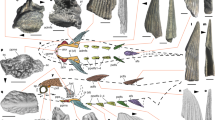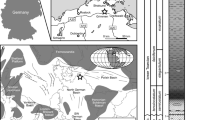Abstract
The appearance ofLissodus sp. NM in the Rotliegend of the NE Saar-Nahe basin extends the knowledge of this genus of the superfamily Hybodontoidea. Additional to some isolated teeth, which represent the most important diagnostic feature, many scales and a spine fragment could be described from the Niedermoschel locality. The functional morphology of the scales will be discussed on the basis of wellknown results from Recent sharks.
Kurzfassung
MitLissodus sp. NM erweitern sich die Kenntnisse zu diesem Genus der Superfamilia Hybodontoidea. Aus dem Rotliegend des nordöstlichen Saar-Nahe-Beckens bei Niedermoschel können neben Einzelzähnen, für die Determinierung bislang wichtigste diagnostische Elemente, auch Placoidschuppen sowie ein Flossenstachelfragment beschrieben werden. Die Morphologie der Placoidschuppen wird aufgrund bekannter funktionsmorphologischer Forschungsergebnisse diskutiert.
Similar content being viewed by others
Literatur
Agassiz, L. 1833–43. Recherches sur les poissons fossiles. 3. Contenant l’Histoire de l’Ordre des Placoïdes. - 422 S., Neuchâstel (Petitpierre).
Boy, J. A. &Fichter, J. 1982. Zur Stratigraphie des saarpfälzischen Rotliegenden (?Ober-Karbon — Unter-Perm; SW-Deutschland). - Zeitschrift der Deutschen Geologischen Gesellschaft133: 607–642, Hannover.
Brough, J. 1935. On the structure and relationships of the hybodont sharks. - Memoirs and Proceedings of the Manchester Literary and Philosophical Society79: 35–50, Manchester.
Compagno, L. J. V. 1987. Die Hai-Arten. - [In:]Keller, J. (ed.) Haie: 18–35, Hamburg (Jahr-Verlag).
Duffin, C. J. 1985. Revision of the hybodont selachian genusLissodus Brough (1935). - Palaeontographica, (A)188(4-6): 105–152, Stuttgart.
— 1989. Comments on the Mesozoic record ofLissodus (Selachii, Hybodontidae). - Mesozoic Research2(2): 83–90, Leiden.
Forey, P. L.;Young, V. T. &McClure, H. A. 1992. Lower Devonian fishes from Saudi-Arabia. -Bulletin of the British Museum of Natural History (Geology)48(2): 25–43, London.
Gebhardt, U. 1986. Ichthyolithen aus dem Stefan C (Oberkarbon) der Saalesenke (DDR). - Freiberger Forschungs-Hefte, (C)410: 65–76, Leipzig.
— 1988. Taxonomie und Palökologie vonLissodus lacustris n.sp. (Hybodontoidea) aus dem Stefan C (Oberkarbon) der Saalesenke. - Freiberger Forschungs-Hefte, (C)419: 38–44, Leipzig.
Gross, W. 1973. Kleinschuppen, Flossenstacheln und Zähne von Fischen aus europäischen und nordamerikanischen Bonebeds des Devons. - Palaeontographica, (A)142: 51–155, Stuttgart.
Hampe, O. 1989. Revision derTriodus-Arten (Chondrichthyes: Xenacanthida) aus dem saarpfälzischen Rotliegenden (Oberkarbon-Perm, SW-Deutschland) aufgrund ihrer Bezahnung. - Paläontologische Zeitschrift63(1/2): 79–101, Stuttgart.
— 1991. Erstfunde oberkarbonischer Hybodontierzähne aus dem Saar-Nahe-Gebiet. - Mainzer geowissenschaftliche Mitteilungen20: 119–130, Mainz.
— 1994. Neue Erkenntnisse zur permokarbonischen Xenacanthiden-Fauna (Chondrichthyes: Elasmobranchii) und deren Verbreitung im südwestdeutschen Saar-Nahe-Becken. - Neues Jahrbuch für Geologie und Paläontologie, Abhandlungen192 (1): 53–87, Stuttgart.
Heidtke, U. 1989. Ein hybodontoider Euselachier (Pisces) aus dem Rotliegenden (Unterperm) der Pfalz (Westdeutschland). -Mainzer geowissenschaftliche Mitteilungen18: 43–48, Mainz.
Johnson, G. D. 1981. Hybodontoidei (Chondrichthyes) from the Wichita-Albany Group (Early Permian) of Texas. - Journal of Vertebrate Paleontology1(1): 1–41, Norman/Oklahoma.
Maisey, J. G. 1975. The interrelationships of phalacanthous selachians. - Neues Jahrbuch für Geologie und Paläontologie, Monatshefte1975(9): 553–567, Stuttgart.
Malz, H. &Poschmann, M. 1993. Erste Süßwasser-Limuliden (Arthropoda, Chelicerata) aus dem Rotliegenden der Saar-Nahe-Senke. - Osnabrücker naturwissenschaftliche Mitteilungen19: 21–34, Osnabrück.
Murry, P. A. 1981. A new species of freshwater hybodont from the Dockum Group (Triassic) of Texas. - Journal of Paleontology55(3): 603–607, Lawrence/Kansas.
Patterson, C. 1966. British Wealden sharks. - Bulletin of the British Museum of Natural History (Geology)11: 281–350, London.
Reif, W.-E. 1974. Morphogenese und Musterbildung des Hautzähnchen-Skelettes vonHeterodontus. - Lethaia7: 25–42, Oslo.
— 1982. Morphogenesis and function of the squamation in sharks. - Neues Jahrbuch für Geologie und Paläontologie, Abhandlungen164: 172–183, Stuttgart.
— 1985. Squamation and ecology of sharks. - Courier Forschungs-Institut Senckenberg78: 1–255, Frankfurt a. M.
Seilacher, A. 1943. Elasmobranchier-Reste aus dem oberen Muschelkalk und dem Keuper Württembergs. - Neues Jahrbuch für Geologie und Paläontologie, Monatshefte1943: 256–292, Stuttgart.
Soler-Gijon, R. 1993. Presencia del géneroLissodus (Chondrichthyes, Selachii) en el Carbonífero Superior de Puertollano (Ciudad Real, España): Consideraciones Paleoecológicas. - Revista Española de Paleontología, N∘ Extraordinario: 118–129, Madrid.
Stapf, K. R. G. 1990. Einführung lithostratigraphischer Formationsnamen im Rotliegend des Saar-Nahe-Beckens (SW-Deutschland). - Mitteilungen der POLLICHIA77: 111–124, Bad Dürkheim.
Stensiö, E. A. 1921. Triassic fishes from Spitzbergen. Part I. - 307 S., Wien (Holzhausen).
Tway, L. E. &Zidek, J. 1982. Catalogue of late Pennsylvanian ichthyoliths, Part I. - Journal of Vertebrate Paleontology2(3): 328–361, Norman/Oklahoma.
— 1983. Catalogue of late Pennsylvanian ichthyoliths, Part II. - Journal of Vertebrate Paleontology2(4): 414–438, Norman/Oklahoma.
Wang Shitao &Turner, S. 1985. Vertebrate microfossils of the Devonian-Carboniferous boundary, Muhua Section, Guizhou Province. - Vertebrata palasiatica23(3): 224–234, Beijing.
Young, G. C. 1982. Devonian sharks from south-eastern Australia and Antarctica. - Paleontology25(4): 817–843, London.
Zangerl, R. 1979. New Chondrichthyes from the Mazon Creek fauna (Pennsylvanian) of Illinois. - [In:]Nitecki, M. H. (ed.) Mazon Creek Fossils: 449–500, New York (Academic Press).
Author information
Authors and Affiliations
Rights and permissions
About this article
Cite this article
Hampe, O. Dermale Skelettelemente vonLissodus (Chondrichthyes: Hybodontoidea) aus dem Unterperm des Saar-Nahe-Beckens. Paläont. Z. 70, 225–243 (1996). https://doi.org/10.1007/BF02988280
Received:
Accepted:
Issue Date:
DOI: https://doi.org/10.1007/BF02988280




